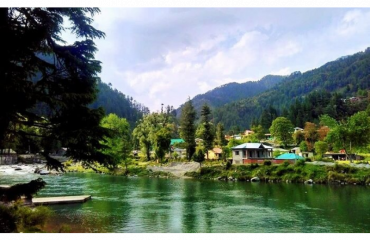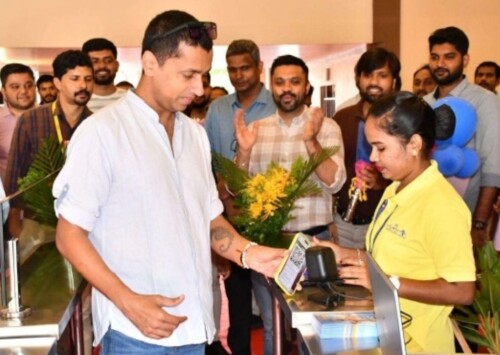Barot Valley: Himachal Pradesh’s untouched paradise
From trout fishing to colonial relics

Beyond its beauty and adventure, this humble hamlet ironically owes its identity to British (Photo: HP Government)
In the Himalayan state of Himachal Pradesh, where popular destinations like Shimla, Manali, and Dharamshala dominate the spotlight, lies the hidden gem of Barot Valley. Nestled alongside the ever-changing Uhl River, this small town offers a multifaceted charm that sets it apart from the typical mountain retreat.

Beyond its beauty and adventure, this humble hamlet ironically owes its identity to British (Photo: HP Government)
Which place comes to your mind when thinking about Himachal Pradesh? Shimla, the British-era summer capital, is known for its cool climate, colonial architecture, snow-capped mountains, and lush green pastures Or is it Manali, famous for its biting cold, high-altitude Rohtang Pass that is covered by snow even in summer and the powerful Beas River flowing alongside the town? For a spiritual retreat, Dharamshala, home to the Dalai Lama, is the place to be.
But beyond these well-known destinations, Himachal Pradesh has many hidden gems and a small town in Mandi, nestled beside the Uhl River, Barot Valley, is one such unexplored place in the state.
Barot Valley
Known as one of India’s ‘Mini Switzerland,’ Barot Valley truly lives up to its name, with its breathtaking landscapes resembling the Swiss countryside!!
Located 75 km from Mandi, this charming hamlet is surrounded by lush green meadows, dense forests, and snow-capped mountains. The sparkling, ever-changing Uhl River flows through the town, accompanied by towering pine trees—as if the Swiss Alps have found a home in India! This makes it a must-visit destination for nature lovers.
Surrounded by natural landscapes, Barot Valley is considered a paradise for adventure lovers. This small town serves as a base for many treks, with various trails passing through the valley, leading to notable places like Bada Bhangal, Kullu, Manali, Billing, and Kothi.
The 13 km trek from Barot to Kothi, winding through cedar and pine forests, offers trekkers a serene experience and a close connection with nature.
After completing the Barot-Kothi trek, trekkers reach the picturesque village of Kothi Kohar, located about 12 km from the valley. This charming village is home to a hidden waterfall, offering a tranquil escape. Nearby, the Nor Jot trek awaits, with its snow-covered peaks and glaciers. It is a perfect reminder that with a little effort, we can discover the serenity of nature and find peace within ourselves.
A British connection
But beyond its natural beauty and adventure offerings, this unassuming hamlet ironically derives its identity from the British, with its colonial past deeply marked by the empire’s influence.
For instance, in collaboration with King Karan Sen, the then ruler of Joginder Nagar in the princely state of Mandi, British engineer Colonel B C Batty developed India’s first hydroelectric power plant, the Shanan hydroelectric powerhouse.
Commissioned in 1932, this historic power plant stands as a testament to early engineering marvels, nestled amidst dense deodar forests. It was built alongside a four-stage haulage rail network, adding to its charm and legacy. Drawing power from the Uhl River, the project originally envisioned five power plants harnessing the river’s energy, a bold ambition for its time!
Currently, under Punjab’s control, the Shanan power plant’s 99-year lease expired in March 2024, reigniting a dispute between the Punjab and Himachal Pradesh governments.
Yet, in a twist of irony, the very roots of this controversy—the house of Colonel Batty, the man behind the hydroelectric powerhouse—still stands quietly in the town!
This house and the power plant stand as enduring symbols of the British Empire’s grip on this town, one that lingers even today, much like in other parts of Himachal Pradesh, including in the state capital, Shimla.
Barot Valley’s other side
But, beyond its adventure and colonial past, Barot Valley has much more to offer. The stunning Uhl River, which changes colour throughout the day, originates from the Thamsar Glacier. Along with places like Luhandi, Puran Hatchery, Lachkkandi, Tikkar, Balh, and Kaman, the Uhl River is considered one of the key angling hubs of the state.

Uhl river
Thanks to its cold, clear waters and the gradual establishment of breeding farms along its banks, the Uhl River has become a hotspot for trout fishing. Anglers, both domestic and international, flock here, especially during the peak season from late August to October, to test their skills. Thus, making the task of catching fish a relaxed recreational activity.
Additionally, this river also serves as a hub for camping and various adventure sports activities.
But, this cup-shaped town also has a spiritual and historical side. About 50 km away from Barot, there is a temple named Masoor Rock Temple, which is known for its beautiful rock-cut architecture.
Dedicated to Lord Shiva, this temple boasts of Lord Ram and Goddess Sita’s stone images with the god of destruction at the centre! Inside the temple, visitors can find a water pond in a rectangular shape, that is considered to be auspicious.
Behind the majestic Dhauladhar Range lies the serene Chuhar Valley, a hidden gem within Barot Valley. Blanketed by dense forests, this quaint village holds a unique tradition, no one is allowed to cut trees for personal use without seeking permission from the village’s revered deity, Hurang Narayan. Adding to its spiritual significance, Chuhar Valley is where the grand Mandi Maha Shivratri festival is celebrated for seven days during February and March. Such deep-rooted traditions are a testament to why Himachal Pradesh is also known as Devbhoomi, the Land of Gods.
Hence, Barot Valley is a place of striking contrasts, offering more than just the typical mountain retreat. So, if you are looking to escape the summer heat and embrace the beauty of spring, the underrated town of Barot, nestled in the Mandi district, is a destination worth considering!









